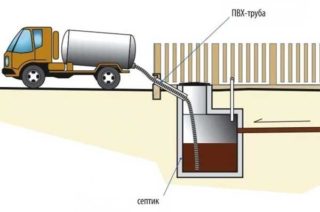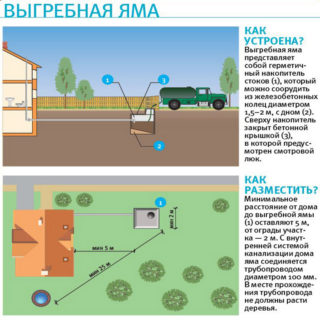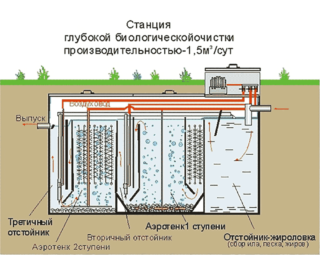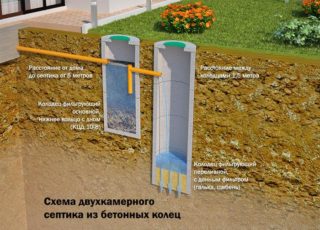A cesspool in a private house is a necessary element of comfort, but its arrangement must be approached competently. Errors in the choice of location and design flaws lead to the appearance of an unpleasant odor that will bother the residents.
Definition and purpose of cesspools
In private houses, septic tanks are filled with waste from the toilet and water with chemical dishwashing detergents, shampoos, gels, acidic kitchen detergents. Such drains must be periodically pumped out and disposed of.
Regulatory Requirements
The pit for the sewer must be made in accordance with the existing sanitary and hygienic standards. This should be done for two reasons:
- The safety of the residents themselves. Poisonous waste through the soil enters agricultural crops, and with them into the human body, which can cause poisoning or infection.
- If you ignore the requirements, the inspection authorities have the right to demand the reorganization of the septic tank, which will entail additional costs and expenses.
The cesspool should be located at a distance of more than 10 meters from residential buildings, at least 25 meters from the source of drinking water. You cannot make a septic tank in the lowest place of the site - in the spring it can be flooded. It is important that a pumping machine can drive up to the septic tank.
Principle of operation
There are even more innovative solutions - biological treatment plants for a private house. At the exit, 98% purified water is obtained, which is poured out into the street or used for irrigation, and fertilizer for plants is obtained from organic waste.
The simplest solution is to bring the sewer pipes to the septic tank made of concrete rings, periodically ordering a sewer truck. The bottom can be both open and sealed.
Dry closets are a good solution for summer cottages and temporary residence, but it is not enough for permanent use, since the device has a small volume and collects waste only from the toilet bowl.
Types of pits and device
Install purchased molded waste storage containers. They are more expensive and require preliminary preparation, but in the process of operation they are more profitable.
The cesspool is laid out of bricks and covered with concrete from the inside for tightness. The bottom is poured with concrete and reinforced so that it does not deform over time. If a cesspool without a bottom is planned, a layer of sand or gravel is poured down.
Most septic tanks are made of concrete rings and the joints are sealed with a solution. Then a hole is cut out to feed the pipe.
Pits from car tires are an unreliable solution, since rubber loses its properties under the influence of low temperatures, and liquid seeps into the ground, causing it to silt. This option is considered as a temporary septic tank.
Carrying out the necessary calculations
Before starting work, you need to perform volume calculations, depending on how many people live in the house and how much water is used daily. These indicators affect the depth and width of the pit. They also determine the volume of wastewater that the soil absorbs per day. It depends on what kind of soil is on the site: if it is mixed with sand, the volume will be greater. Clay practically does not allow water to pass through.
Next, markings are carried out on the territory of the house - where the pipe will come from, what slope must be observed for gravity sewage, what is the distance to the septic tank. It is desirable that the line is straight, then there is no need to additionally equip inspection wells or put an audit in case of blockages.
Given the results obtained, you can start digging a pit.
Features of the installation of a cesspool for a private house
- preparation of a pit in the ground;
- laying plastic containers, bricks or concrete rings;
- sealing, insulation, if necessary, if the soil freezes in winter;
- laying pipes from the house to the septic tank;
- check of work.
To dig a hole, you need the help of an excavator or neighbors with shovels. The width is made more by 20 cm, where crushed stone or sand will subsequently be poured.
A crane is also needed to lay the concrete rings, since it will be difficult to manually put heavy products, in addition, there is a risk of dropping and breaking the structure. No equipment is needed for a plastic container; it is placed manually. The longest time is to lay out a septic tank from a brick and then cover it with a solution.
For insulation, polystyrene foam sheets are used, which are laid on the outside and reinforced with electrical tape. This material does not allow moisture to pass through and does not deteriorate for a long time.
After the pipes are laid and the pit is connected, the water is turned on in the house and the liquid is monitored. If everything works, you can fill the trenches with sand and earth. Put a lid on top. The cesspool is ready.
Operation and maintenance

If the sump is done correctly, there are usually no problems with its operation. Regular emptying of the septic tank is required.
You can get rid of the smell with biological agents based on bacteria. In 3-4 days they process the waste water and the smell disappears. This is usually done in the warm season, because at low temperatures microorganisms cannot actively process organic matter and multiply. There are products on the market that contain bacteria that are resistant to chemicals. They are more expensive, but they work well and eliminate the stench in a short time. It is enough to carry out the procedure once a year.
A cesspool without pumping out requires more attention, since silting the bottom reduces the rate of liquid absorption into the soil. After 5–6 years, disposal using a sewer truck may be required.
In two or three-section septic tanks, excess liquid is self-utilized. Solid waste is decomposed with biological agents. Subsequently, the processed waste is dug up with the soil to restore the nutrient characteristics of the soil.
Advantages and disadvantages of cesspools
If in a summer cottage there is no other way to remove sewage waste, a cesspool on the site is only an advantage, but it requires additional costs for pumping out.If the septic tank is single-chamber, it will be necessary to take out the waste often.
On a site where it is possible to equip a pit further from the house and the type of soil allows, they usually build it with an open bottom. In this case, the bulk of the waste will be disposed of independently through the soil. Once a year, you will have to pump out the solid waste using a machine or a fecal pump with a shredder. In rural areas, special compost heaps are made, where the contents are moved for further use. To do this, nitrogen-containing feces are poured with carbon-containing components - straw, sawdust, branches, paper, hay, dry foliage. Decay time - 1.5 years from the moment of laying. The ratio of substances is 1 part of feces, 4 parts of carbon components.
Self-arrangement of the pit will require less costs. Prices for ready-made cesspools will be higher, but companies provide a guarantee for their work and service them periodically.












